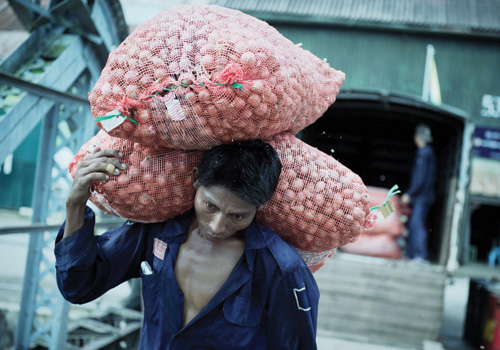Myanmar: Crisis brewing in onion market, local producers at risk
A rise in illegal onion imports from China is crowding out local onion producers and could eventually lead to an oversupply and lower prices.
Onions from China first entered the country on a large scale in 2015, when the Ministry of Commerce authorised the import of 800 tonnes of onions from China and Thailand to help control escalating prices. That year, onion prices rose a record high of K3,000 per viss (1.6kg), according to government media reports.
This year, imported supplies have exceeded what is produced locally, said U Win Myint, secretary of the Onion, Garlic and Kitchen Crop Producers Association in Mandalay Region.
Currently, local onion prices are about K1,650 per viss, which is higher than last year, when onions were selling for below K1,000 per viss. Onion prices rose sharply this year after bad weather during harvesting season in April damaged up to a third of local crops. Prices were further inflated as farmers, wary of the rising incoming supply of Chinese onions, held production levels in check, U Win Myint said.
Against that backdrop, producers in China have been dumping large supplies of onions into the local market to take advantage of the higher price. In fact, onion imports are actually prohibited in Myanmar.
Meanwhile, some traders also take advantage of the almost similar import titles for onions (kyat twin ni in Myanmar language) and garlic (kyat twin phyu) to smuggle more onions across the border.
“In the media, about 200 tonnes of Chinese onions are reported to have entered the market. We can say that the actual number is many times more. If the import numbers are really 200 tonnes, we don’t have to worry because that is actually a small number,” U Win Myint said.
So far, local producers say the government has not taken any action against illegal smuggling of onions across the Myanmar-China border.
Quality control
The authorities must move fast before an oversupply builds up and prices start falling, though. More importantly, Chinese onions are typically of lower quality than locally produced onions. As such, an influx of China-produced onions combined with a drop in local production could damage the overall quality of onions consumed in the domestic market.
“Chinese onions are not up to standard among local consumers as they typically store for a week compared to a year for locally produced onions. In a normal market, demand for Chinese onions should dry out. Yet, local producers face challenges on the cost front and as more supplies from China is smuggled in,” said U Win Myint.
Export woes
Moreover, Chinese producers have started to up their game with technology. “Using high-tech harvesting techniques, China has been able to produce large volumes of garlic,” said U Win Myint.
That could have serious consequences for local onion exporters. In Myanmar, onions are harvested over the summer, winter and rainy seasons. During the summer, onions produced in the Mandalay, Sagaing and Magway regions exceeds local demand and are typically exported to countries including China.
This year though, demand from China has dwindled due to higher export prices and rising volumes produced by the Chinese. “This year, exports to China have been less than the previous year. Last year, we were able to export for six months. This year, we only managed to export for three months between March, April and May,” he said.
“We urge the government to step in with measures to protect our local onion producers.”
Source: http://www.mmtimes.com/index.php/business/27379-crisis-brewing-in-onion-market-local-producers-at-risk.html


 Thailand
Thailand




